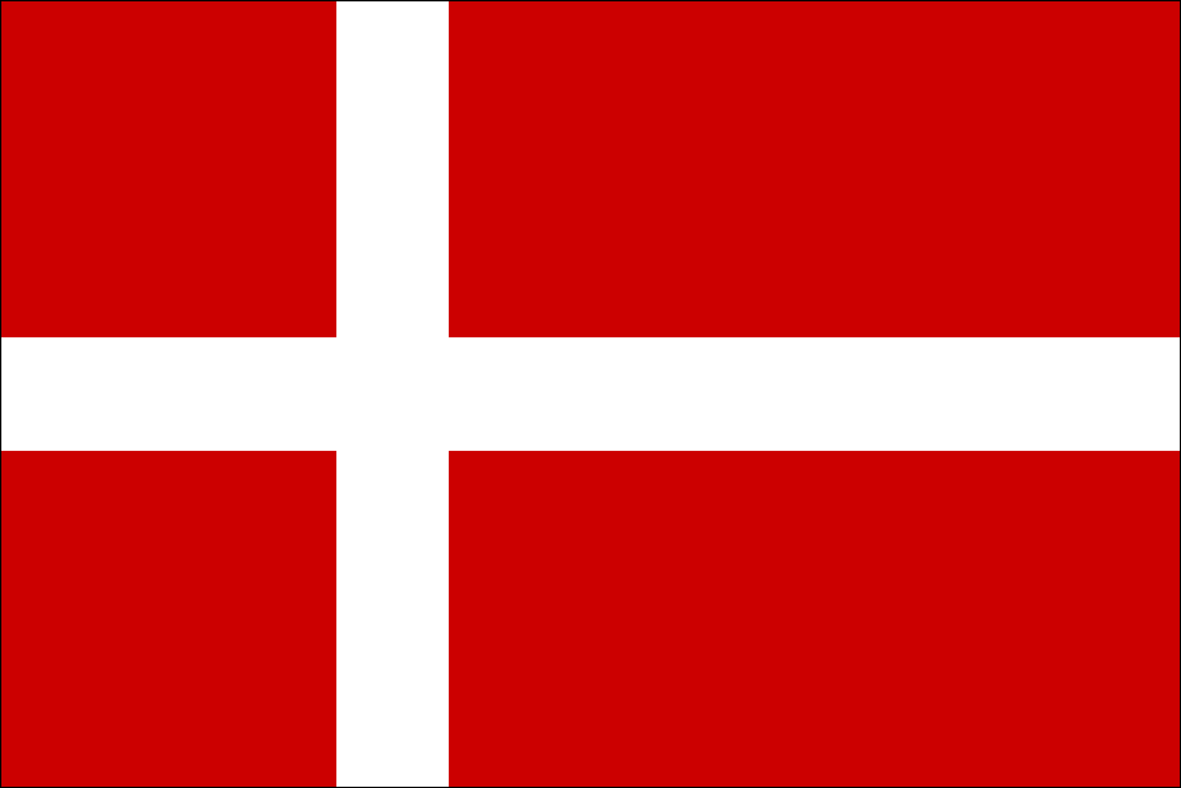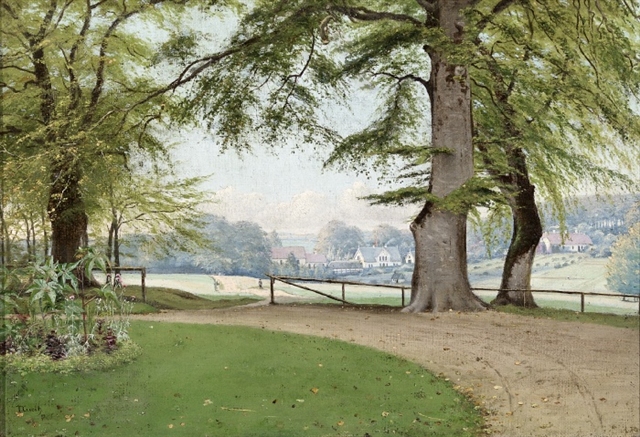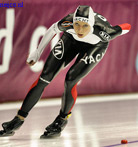Denmark
Main sources: Preben Gorud Petersen, Arild Gjerde and Marnix Koolhaas
Former backwards superpower moving forward
Nature has given the Danes pretty good conditions for the development of skating. There are fjords, rivers, lakes and harbour areas that occasionally freeze in the wintertime, and they were rarely bothered with snow covering the ice. Thus, skating has been practised in Denmark for eons, and the archaeologists find lots of ice-legs used by Vikings to cross the ice. Danish winters are colder than the Dutch ones, and there are only historical reasons why Denmark isn’t quite as much a superpower as that southern neighbour.
The first clubs were founded in Copenhagen and Frederiksberg already in 1869. The Copenhagen club, Kjøbenhavns Skøjteløberforening, or KSF for short, still is active and one of the oldest existing skating clubs worldwide. Competitive skating started early, too, as the first races were held on January 23, 1871 on the Sortedamsøen lake in the heart of Copenhagen. Not many countries have records of earlier races. KSF joined the ISU in 1893, when the federations of the Netherlands, Britain and Germany/Austria, and clubs from Stockholm, Budapest and Hamar were the only other members. Skating was enormously popular these early days, and the late 19th century was blessed with a number of good, cold winters. From 1885 and for many years afterwards, Peblingesøen, adjacent to Sortedamsøen, with a size of 500m by 200m, became the great speedskating centre in Denmark, regularly used in cold winters until 1956, and the national championships there always pulled thousands of spectators.
But despite this popularity, resources were never set in on the facilities side. National races were almost exclusively held on lake or sea ice. On-land rinks were rare and transient. Also, speedskating in Denmark is very exclusive to Copenhagen. KSF for many years was the only club to arrange speedskating in Denmark. It is not known if the Frisians of the southwest have ever practised any speedskating. It is known however that Allan Heilmann, the Danish champion 1924 and 1929 (and the husband of the well-known singer Biddy Heilmann), was appointed sand dune warden at Skagen in the 1920s and laid out his own track there. His son Niels probably skated his first strokes on that track, but no results are known.
As international speedskating grew, Danish skaters found it hard to compete with rivals from countries with better facilities and longer, colder and more reliable winters. But they found a specialty: backwards skating! Backwards races were a part of the Danish Championships until 1924, and the backwards times often were comparable to the forward ones. Danish backwards skaters set several world records, some of which still survive. Especially remarkable is a 500m in 59,0 by Vilhelm Hastrup in 1912.
 The first Danish international skater was Thorvald Groth, an architect and landscape painter from Copenhagen who competed in the first races at Sortedamsøen and entered international meets in Denmark, Norway and Germany 1885-1887. Before his untimely death in 1891, 44 years old, he published a handbook of skating and ice preparation that is said to have been known throughout Europe. Groth lived just long enough to see the next international Dane, Emil Schou, who participated in the Hamburg European Championship 1891, apparently a Hamburg resident and member of the organising club. And he was a skilled skater, finishing 5th in the shorter distances and 2nd in the 3 mile race ahead of the strong Hamar skater Adolf Norseng. Overall, he would have won a bronze medal according to the reckoning that was introduced
in 1908.
The first Danish international skater was Thorvald Groth, an architect and landscape painter from Copenhagen who competed in the first races at Sortedamsøen and entered international meets in Denmark, Norway and Germany 1885-1887. Before his untimely death in 1891, 44 years old, he published a handbook of skating and ice preparation that is said to have been known throughout Europe. Groth lived just long enough to see the next international Dane, Emil Schou, who participated in the Hamburg European Championship 1891, apparently a Hamburg resident and member of the organising club. And he was a skilled skater, finishing 5th in the shorter distances and 2nd in the 3 mile race ahead of the strong Hamar skater Adolf Norseng. Overall, he would have won a bronze medal according to the reckoning that was introduced
in 1908.
The next Dane we hear from is Ejnar Sørensen, who showed up at the Stockholm 1905 European Championship, collecting as his best a 10th place in the 10000 m. In 1907, he came to the worlds in Trondhjem, and he’s even present at the famous World Championship in Davos 1908, skating a reasonably good 10000 m in 19.07.4, a 9th place finish. Still he was denied a start among the elite at the World Championship 1909, and had to skate in the junior class. In the mild winter of 1910, he did enter the wet European Championship in Viborg, with two 13 places as his meagre harvest. But when he reappeared in 1911, he had improved considerably in the shorter distances, and made some serious impact for the first time with a 5th place in the 1500 m at the European Championship in Hamar and an 8th place overall in both championships. His last season was 1912, when he set a string of national records in Davos. Besides speedskating he practised other sports and is said to excel in rowing. Unfortunately, he died in 1912 from the flu, at the height of his career.
Then there is quiet for a while. The Danish skating federation is formed 1912 and joins the ISU. However, the system demanding pre-appointed meets suits the Danes poorly with their unstable winter conditions. Two world wars come and go. The 30s are a particularly bleak period with no skating winters at all. But Aage Justesen, a Danish printer who lived in Zürich, skated in his spare time and achieved decent times at races in Davos. Already in his first season, he improved Sørensen’s Danish record in the 500m. The next four seasons he brought it down to 45.1, but then stopped skating.
The war brought cold winters, and in 1941 and ’42, the 6th and 7th Danish championships were held and won by Erik Hviid. The well-known Norwegian skater Mons Mjelde was in the country, coaching the Danes. Hviid and his brother Jørgen also were amongst the best ice-hockey players in the country. The level was not world-class, however, and a newspaper report from the ice hockey World Championship in Sweden 1949, where Denmark met Canada at the first group stage and were beaten 47-0, is cogently to the point. The report states that once when the Danish champion in speedskating, Erik Hviid, pulled through, a Canadian back gave chase and caught up with him, skating backwards. Apparently, Hviid wasn’t such a backwards specialist as Hastrup and his contemporaries. One does get a feeling that the report might be slightly over-stated. And the history section of the KSF site indicates that the story has grown even wilder over the years.
1947 was a long, cold winter, too, and when the international championships resumed, a couple of Danes were present, coached by Mjelde: Niels Heilmann and Svend Erik Jacobsen. But their results are not excellent. Next year, the Olympic Games returned to Switzerland, and Justesen seizes the opportunity. He hasn’t skated competitively in 7 years, but quickly convinces the Danish Olympic committee that he should take part. He becomes Denmark’s first Olympic speedskating participant at the St. Moritz games with a 29th place in the sprint at 46.4, with as many as 11 men behind him in the lists, before he finally vanishes from skating.
Then there is a series of mild winters until 1954-1956, when the Danish championships were arranged three years in a row. Two of them were won by Kurt Stille, a musician who moved to Finland in the summer of 1956 to start a band playing dance music, and found better facilities for speedskating there. At the world championship in Östersund
1957, the list of participant nations was extended with a Dane
and a Spaniard, who formed the rear in the lists. This is where Kurt Stille, the Dane, earned his nickname “Den baskende krage” (the flapping crow). But unlike the Spaniard, he was to return. Already next season he climbed considerably in the lists. In 1958 he moved to Norway, and under the instruction of people like Harry Haraldsen and Aage Johansen, he climbed further upwards.
At the Bislett European championship 1960, he achieved the first
in a series of annoying 17th places in the 5000m, just missing
the qualification limit for the 10000. At the Squaw Valley games
he had another of these 17th places in the 10000m, at—you’ll
be damned—exactly 17 minutes. After a poorer season in 1961,
the curse of the 17 still haunted him in 1962, when he achieved
this position at the 5000m in both championships.
But the following winter, with some rub-off from the new, revolutionary methods and equipment of his Norwegian friends, his breakthrough came at the Gothenburg European championship, where he finished 9th in the 5000m and 14th overall. At the world championship in Karuizawa he was unlucky, but in 1964 he completed both championships, reaching 13th overall at the Helsinki worlds with a bit of help from some wobbly-feeted rivals. His Olympic harvest was good, with a 12th place in the 5000 and 9th in the 10000m, again being somewhat lucky on the latter distance to skate in the last pair before the fatal Låftmann preparations. Stille was a great favourite of the fans, but quit after the Olympic season to take up cross-country skiing, where he was seen at exercise class races for years to come.
After Stille, there is quiet on the Danish speedskating front for a long while. The Copenhagen club stopped their speedskating activities after 1964. But in 1972, another club, Hurtigløberforeningen af 1972, was formed. They arranged races on Løjesø at Holte just north of Copenhagen, and their members Tom Lausen and Lars Traberg entered Scandinavian meets in the 1980s and 90s, without achieving world class results. The first ice-halls were built in 1959—today, there are 15. They are used mostly for figure skating, where decent results lately have been achieved, and for ice hockey. Only a couple of clubs practise short track seriously yet.
Then in 2002, the situation improved dramatically for the better. A huge artificial outdoor rink was set up at Genforeningspladsen
in Copenhagen, using removable refrigerating equipment. Apparently the Danish Foundation for Culture and Sport Facilities had been infiltrated by people from HLF72. Already the first season, races were held, and they have since been continued annually. One of the participants in the first Genforeningspladsen races was Oliver Sundberg, an inline skater, who won the two longest distances. With the Olympic Games in Torino approaching, he returned in 2005, and this time was joined by fellow inliner Cathrine Grage. They made their first skating trip abroad in March that year to skate in Groningen, and Kurt Stille lost his first two Danish records.
 Next season saw dramatic improvement, and the Danish records were crushed on all distances. They went to Torino to participate in the World Cup, and the non-flapping Grage scored her first World Cup points the week after in Inzell. Their Torino times qualified them for the European Championship, and they both competed at Hamar where they attracted a lot of attention, but mostly for their nationality. They were not selected for the Games, though, and dropped the World Cup for the rest of the season, with one exception: the 100 m in the finals, for which Grage was qualified, oddly enough.
Next season saw dramatic improvement, and the Danish records were crushed on all distances. They went to Torino to participate in the World Cup, and the non-flapping Grage scored her first World Cup points the week after in Inzell. Their Torino times qualified them for the European Championship, and they both competed at Hamar where they attracted a lot of attention, but mostly for their nationality. They were not selected for the Games, though, and dropped the World Cup for the rest of the season, with one exception: the 100 m in the finals, for which Grage was qualified, oddly enough.
Next season saw furter dramatic improvement, especially after a trip to Calgary to skate in the Olympic Oval Finale. They competed in more World Cup meets, and again qualified for the European Championship, where they climbed a little in the lists since last time, but failed to make a huge impact. In the summer, Sundberg was diagnosed with jumper’s knee, and had to give the skating season amiss, but Grage progressed further; she was ever-present in the World Cup, and for the first time qualified for the World Single Distance Championship, where she was #14 and 20 in the two longest distances.
As I am writing this, the 2008/09 World Cup has started, without Oliver Sundberg, who has recently undergone a knee surgery. Grage is present, still with some seconds to make up in order to reach group A level, but with good hopes of attaining her goal of participating in the 2010 Olympic Games. Meanwhile, Anders Holm has achieved times not far from World Cup standard, skating is popular at Genforeningspladsen, and despite the fact that it’s still confined to Copenhagen, there is hope for a brighter future in Danish skating.
Statistics(November 2008):
Danish records:
Oliver Sundberg 11.33 Groningen 5 Mar 2006
Oliver Sundberg 37.98 Calgary 16 Mar 2007
Oliver Sundberg 1.13.38 Calgary 17 Mar 2007
Oliver Sundberg 1.52.60 Calgary 14 Mar 2007
Oliver Sundberg 3.55.83 Calgary 13 Mar 2007
Oliver Sundberg 6.48.67 Calgary 15 Mar 2007
Oliver Sundberg 14.25.57 Erfurt 17 Feb 2007
Oliver Sundberg 150.035 Calgary 16-17 Mar 2007
(37.98-1.14.01-38.36-1.13.38)
Oliver Sundberg 156.135 Calgary 13-15 Mar 2007
(38.43-3.55.83-1.52.60-6.48.67)
Oliver Sundberg 172.044 Arendal 27-28 Jan 2007
(40.28-7.28.83-2.01.10-15.30.3)
Cathrine Grage 12.43 Heerenveen 5 Mar 2006
Cathrine Grage 43.19 Calgary 10 Mar 2007
Cathrine Grage 1.23.07 Calgary 17 Mar 2007
Cathrine Grage 2.03.21 Calgary 17 Nov 2007
Cathrine Grage 4.13.85 Calgary 16 Nov 2007
Cathrine Grage 7.20.45 Kolomna 1 Dec 2007
Cathrine Grage 15.14.90 Calgary 15 Mar 2007
Cathrine Grage 170.245 Calgary 16-17 Mar 2007
(43.49-1.23.82-43.31-1.23.07)
Cathrine Grage 181.579 Gothenburg 20-21 Jan 2007
(45.34-2.14.18-1.30.66-4.37.1)
Cathrine Grage 173.171 Calgary 13-14 Mar 2007
(43.29-4.18.51-2.05.97-7.28.06)
Participants in international championships and Olympic Games:
1.Kurt Stille 17 times
2.Einar Sørensen 5
3.Cathrine Grage 4
4.Svend E. Jacobsen,
Niels Heilmann, and
Oliver Sundberg 2
7.Emil Schou and
Aage Justesen 1